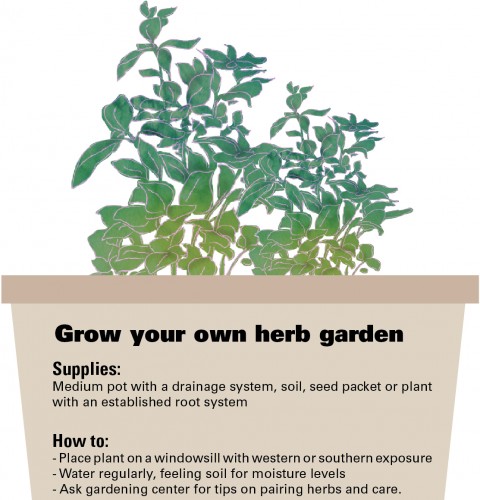
It isn’t easy exercising a green thumb between a two-flat and paved paradise. For many Chicagoans who rent an apartment without a backyard, this often means forgoing gardening, leaving farming to the suburbanites or digging up weeds in a patch of communal land.
But even in the smallest of places a little windowsill and sunlight can allow any urban dweller to cheaply and easily grow herb plants that add fresh flavor to store-bought foods. Even if that space is just a dorm room.
“It just depends on sunlight. I think there’s a way to (grow herbs) if you want to do it,” Ally Carvalho, a freshman Peace, Justice and Conflict Studies major involved with DePaul’s Urban Farming Organization, said. Her sage and cilantro, which she munches on raw or gives as gifts to friends, bask in the sun on her Seton Hall windowsill.
“Soil — it’s outside, you can pretty much pick it up, and sunlight — you don’t have to pay for that,” she said. “You really just have to pay for water, if you’re really strapped, you could put a bucket outside for water. It’s a cheap way of getting fresh food.”
Herbs are sturdy, easy for home cooks or novices and do not need pollination like some outdoor plants, Tracy Colquhoun, who works at Gethsemane Garden Center in Andersonville, said. Because they are often cooked with, it’s handier to have them on a kitchen windowsill or porch nearby.
“I’ve got them in the kitchen, so whenever I’m cooking, they’re right there,” she said. “It is a money saver. Oftentimes you’re buying (fresh herbs) and you don’t need the whole thing. You’ve got your own plant and you can snip a little at a time. And that snipping does encourage them to grow.”
Fresh herbs have a potent and pungent smell and flavor, perfect to season a variety of dishes. Cook pasta or fish with basil, top tacos with cilantro or plunge fresh mint into mojitos. Meat can be skewered onto the thick stems of rosemary and grilled, she said.
Kristen Holdsworth, co-president of DePaul Urban Farming Organization, suggests beginning with mint or basil, which have easy-to-pick leaves and can be chopped into pesto to top fish and bread or whipped into pasta.
“Mint grows like crazy — it’s this crazy plant that loves to grow,” she said. “Basil is always a good way to start because it has a lot of flavor.”
Even indoors, some plants do not make it through the winter due to scarcer sunlight. But excess herbs can be dried or frozen to store. Colquhoun suggested freezing cilantro in ice cubes to maintain its freshness, which can later be dropped straight into a sauté pan.
Though herbs can be purchased anytime, gardening centers tend to stock the greatest variety in springtime. Colquhoun’s co-worker at Gethsemane, John Diversey, said to look for plants with an established root system. Roots fully encircling the outside of its planting medium signals a healthy herb, though most nurseries will assist newcomers.
Certain plants cohabitate better together, depending on their preference for moisture.
“If people wanted to grow basil, they could put that in with parsley and cilantro,” Colquhoun said, noting these plants prefer wetter soil. “Some of the more Mediterranean herbs like sage, thyme and oregano, work well together. Some people call them the pizza herbs.”
At about $5 for seed packets and small pots, the total cost for a beginner’s garden is less than a couple of fresh herb packets. Students are welcome to dig up soil from DePaul’s community garden, Hemsworth said. From there, it’s just a matter of caring for them in a cozy new home — no matter how small.
“Herbs are a great way to segue into gardening,” she said. “It’s a great piece to interact with and people really enjoy something they can eat.”

